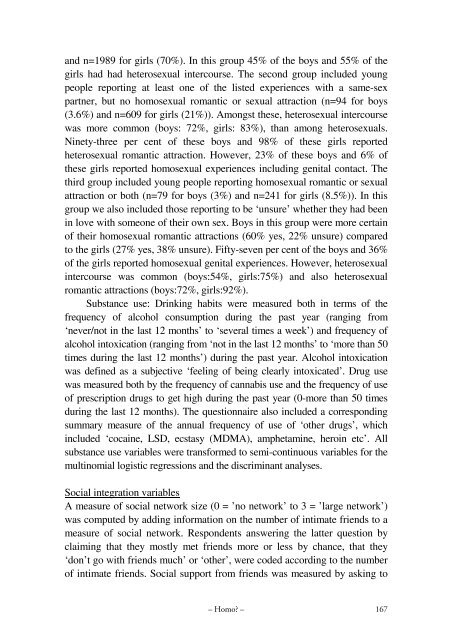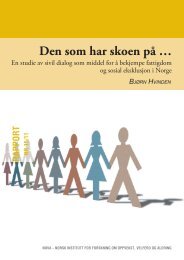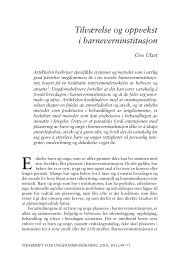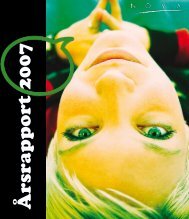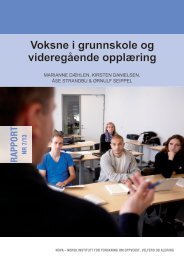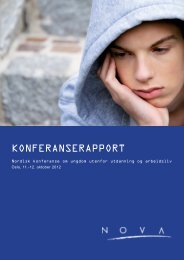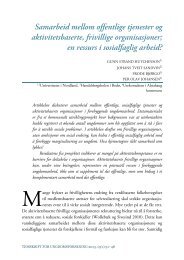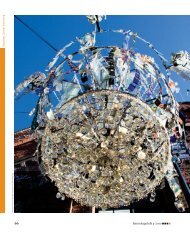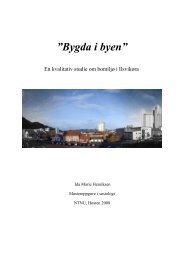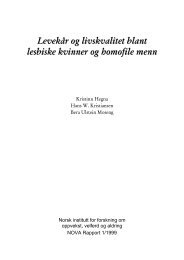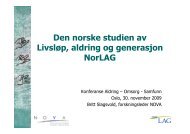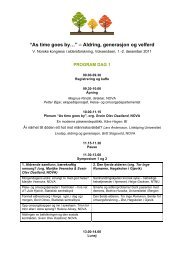Betydningen av seksuell erfaring, tiltrekning og identitet for ...
Betydningen av seksuell erfaring, tiltrekning og identitet for ...
Betydningen av seksuell erfaring, tiltrekning og identitet for ...
You also want an ePaper? Increase the reach of your titles
YUMPU automatically turns print PDFs into web optimized ePapers that Google loves.
and n=1989 <strong>for</strong> girls (70%). In this group 45% of the boys and 55% of the<br />
girls had had heterosexual intercourse. The second group included young<br />
people reporting at least one of the listed experiences with a same-sex<br />
partner, but no homosexual romantic or sexual attraction (n=94 <strong>for</strong> boys<br />
(3.6%) and n=609 <strong>for</strong> girls (21%)). Amongst these, heterosexual intercourse<br />
was more common (boys: 72%, girls: 83%), than among heterosexuals.<br />
Ninety-three per cent of these boys and 98% of these girls reported<br />
heterosexual romantic attraction. However, 23% of these boys and 6% of<br />
these girls reported homosexual experiences including genital contact. The<br />
third group included young people reporting homosexual romantic or sexual<br />
attraction or both (n=79 <strong>for</strong> boys (3%) and n=241 <strong>for</strong> girls (8.5%)). In this<br />
group we also included those reporting to be ‘unsure’ whether they had been<br />
in love with someone of their own sex. Boys in this group were more certain<br />
of their homosexual romantic attractions (60% yes, 22% unsure) compared<br />
to the girls (27% yes, 38% unsure). Fifty-seven per cent of the boys and 36%<br />
of the girls reported homosexual genital experiences. However, heterosexual<br />
intercourse was common (boys:54%, girls:75%) and also heterosexual<br />
romantic attractions (boys:72%, girls:92%).<br />
Substance use: Drinking habits were measured both in terms of the<br />
frequency of alcohol consumption during the past year (ranging from<br />
‘never/not in the last 12 months’ to ‘several times a week’) and frequency of<br />
alcohol intoxication (ranging from ‘not in the last 12 months’ to ‘more than 50<br />
times during the last 12 months’) during the past year. Alcohol intoxication<br />
was defined as a subjective ‘feeling of being clearly intoxicated’. Drug use<br />
was measured both by the frequency of cannabis use and the frequency of use<br />
of prescription drugs to get high during the past year (0-more than 50 times<br />
during the last 12 months). The questionnaire also included a corresponding<br />
summary measure of the annual frequency of use of ‘other drugs’, which<br />
included ‘cocaine, LSD, ecstasy (MDMA), amphetamine, heroin etc’. All<br />
substance use variables were trans<strong>for</strong>med to semi-continuous variables <strong>for</strong> the<br />
multinomial l<strong>og</strong>istic regressions and the discriminant analyses.<br />
Social integration variables<br />
A measure of social network size (0 = ’no network’ to 3 = ’large network’)<br />
was computed by adding in<strong>for</strong>mation on the number of intimate friends to a<br />
measure of social network. Respondents answering the latter question by<br />
claiming that they mostly met friends more or less by chance, that they<br />
‘don’t go with friends much’ or ‘other’, were coded according to the number<br />
of intimate friends. Social support from friends was measured by asking to<br />
– Homo? – 167


